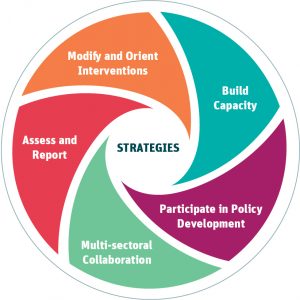Racial Equity Action Framework
Our vision
Reduce systemic racism to ensure those affected have equal opportunities for health.
Our mission
Working with our communities to enable meaningful and sustainable changes to advance racial equity.
Our strategies
We have adopted the National Collaborating Centre for the Determinants of Health’s five Public Health Roles for Racial Health Equity (PDF, 475 KB)1

Build capacity
Build agency understanding and capacity to examine and act on the forces that maintain racial inequities.
Assess and report
Assess and report on the impact of racialization and racism on health.
Modify interventions
Modify and orient public health interventions to reduce racial inequities.
Participate in policy development
Participate in policy development that seeks to address racism.
Multi-sectoral collaboration
Partner with communities and other sectors seeking to address racism.
Systemic racism is when an institution or set of institutions together create or maintain racial inequity. This can be unintentional, and does not mean that people within an organization are racist. It is often caused by hidden biases in policies, practices and processes that privilege or disadvantage people based on race. It can result from doing things how they have always been done without considering their impact on particular groups.1
Racialization is the process for how society constructs races as real, different and unequal. Racial categories are not based on science or biology but on differences that society chooses to emphasize, such as skin colour, language, culture, religion, or place of birth. The process of racialization has significant economic, political and social consequences on people’s lives.1
Agency commitments
Anti-racism
We acknowledge that systemic racism exists and commit our efforts to identify, prevent, reduce, and remove agency policies, practices and processes that maintain racial inequity.2
Voices of people with lived experience
We commit to privileging and amplifying the voices of those with lived and living experiences of racialization.3
Intersectionality
We acknowledge that experiences of racism differ across racialized groups because of an individual’s overlapping or intersecting social identities. Examples of other social identities include gender, socio-economic status, sexual orientation, and citizenship. We commit to understanding unique identities and experiences of racism to inform our efforts to reduce racial inequities.4
Safety
We commit to providing a culturally safe and respectful environment for employees, partners, and clients. We will foster an environment where individuals and groups feel confident that their voices will be heard without fear of being excluded or undermined. We also commit to practicing cultural humility to improve public health programs and services.5, 6, 7, 8, 9
Self-determined health
We acknowledge and support the inherent rights of Indigenous Peoples including the First Nations, Inuit and Métis Peoples to determine their own pathways and to make decisions about their communities, health and livelihoods.10
Social determinants of health
We acknowledge that health is determined by the social and economic conditions and environments in which we live, learn, work, play, grow and age. We acknowledge that racism is one of the social determinants of health and we commit to reducing racial inequities to improve opportunities for health.
Social inclusion
Everyone has the right to feel a sense of belonging and acceptance, and to take part in their community. We commit to increasing social inclusion to ensure employees, partners and clients have equal opportunities to take part in our society.11
Allyship
We will commit to engaging with those with lived and living experiences of racialization to better understand allyship and opportunities for actions that support racial equity.
- Note: the strategies for Public Health Sudbury & Districts’ Racial Equity Action Framework are adapted from National Collaborating Centre for Determinants of Health (2018). Let’s Talk: Racism and Health Equity (Rev. ed.). Antigonish, NS: National Collaborating Centre for Determinants of Health, St. Francis Xavier University. Retrieved from http://nccdh.ca/images/uploads/comments/Lets_Talk_Racism_and_health_equity_EN_web.pdf
- Ontario Anti-Racism Directorate. (2017). A Better Way Forward: Ontario’s 3-year Anti-Racism Strategic Plan. Retrieved from https://www.ontario.ca/page/better-way-forward-ontarios-3-year-anti-racism-strategic-plan.
- Public Health Sudbury & Districts. (2019). Public Mental Health Action Framework. @ Public Health Sudbury & Districts, 2019. O: January 2019.
- Ontario Anti-Racism Directorate. (2017). A Better Way Forward: Ontario’s 3-year Anti-Racism Strategic Plan. Retrieved from https://www.ontario.ca/page/better-way-forward-ontarios-3-year-anti-racism-strategic-plan.
- Singh, B., Winkel, D.E., Selvarajan, T. T. (2013). Managing diversity at work: Does psychological safety hold the key to racial differences in employee performance? Journal of Occupational and Organizational Psychology. 86: pp.242-263. doi:10.1111/joop.12015.
- National Aboriginal Health Organization (NAHO). (2009). Cultural competency and safety in First Nations, Inuit and Métis health care. Fact Sheet. 2009. Retrieved from http://rapworkers.com/wp-content/uploads/2017/07/5.CulturalCompetency_Safety-in-First-Nations_Innuite_Metis-health-care.pdf
- Aboriginal Nurses Association of Canada. Canadian Association of Schools of Nursing. Canadian Nurses Association. (2009). Cultural Competence and Cultural Safety in Nursing Education. A Framework for First Nations, Inuit and Métis Nursing. Retrieved from https://www.cna-aiic.ca/~/media/cna/page-content/pdf-en/first_nations_framework_e.pdf
- The Indigenous Physicians Association of Canada and The Association of Faculties of Medicine of Canada. (2009). First Nations, Inuit, Métis Health Core Competencies. A Curriculum Framework for Undergraduate Medical Education. Winnipeg & Ottawa. Retrieved from https://afmc.ca/pdf/CoreCompetenciesEng.pdf
- Public Health Agency of Canada. Core Competencies for Public Health in Canada, Release 1.0. 2008. Retrieved from http://www.phac-aspc.gc.ca/php-psp/ccph-cesp/pdfs/cc-manual-eng090407.pdf
- Public Health Sudbury & Districts. (2018). Finding Our Path Together. © Public Health Sudbury & Districts, 2018 O: October 2018. Retrieved from https://www.phsd.ca/wp-content/uploads/2018/10/Indigenous_Engagement_Strategy_AODA_2018_EN-2.pdf
- Ontario Anti-Racism Directorate. (2017). A Better Way Forward: Ontario’s 3-year Anti-Racism Strategic Plan. Retrieved from https://www.ontario.ca/page/better-way-forward-ontarios-3-year-anti-racism-strategic-plan.
This item was last modified on April 2, 2024
